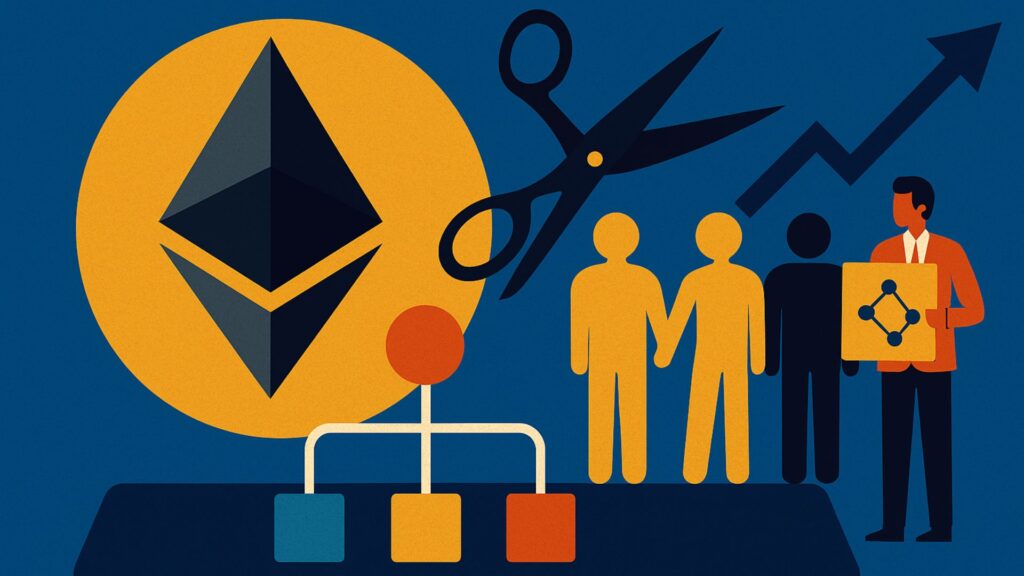The Ethereum Foundation has made its most dramatic internal shift in years. Several key R&D staff have been let go, and the entire division has been restructured under a new name, which is Protocol.
While layoffs often signal trouble, the Foundation says this is about sharpening focus, speeding up execution, and scaling Ethereum for the world. So what exactly is changing, and how will this impact the blockchain’s future? Let’s take a closer look at this controversial but strategic reset.
Ethereum Restructures Its Team To Move Faster and Focus Smarter
On Monday, the Ethereum Foundation confirmed that it had dissolved its long-standing Protocol Research and Development team. In its place, a newly focused unit named simply Protocol will now take the lead.
Some team members were let go as part of this transition, a move the Foundation openly acknowledged and described as difficult but necessary.
This decision was not about individual performance. It was part of a broader strategy to create what the Foundation calls a more responsive and effective team. The reasoning is clear.
Ethereum is no longer a niche experiment. It is now a global platform supporting billions in assets and millions of users. That scale puts pressure on it to deliver quickly, with precision and consistency.
In recent years, Ethereum’s development process has often been criticised for being too academic, too slow to move from research to deployment. While the Foundation has produced world-class research, the transition to real-world application has not always been smooth.
The new structure is designed to fix that. By focusing on execution, cutting out inefficiencies, and assigning clearer responsibilities, the Foundation hopes to accelerate development across its most critical areas.
This isn’t just a shift in team structure, it also reflects changes in how the Ethereum Foundation operates more broadly.
The organisation has begun managing its treasury more strategically, placing assets in DeFi protocols like Aave, Compound, and Spark to earn sustainable yield instead of selling ETH. That same mindset, lean, smart, and deliberate, is now being applied to the core development team.
Despite the layoffs, the Foundation showed respect for the contributors who are departing. It encouraged other teams in the Ethereum ecosystem to offer them opportunities, emphasising that their skills are still valuable to the future of decentralised technology. This was not a rejection, but a redirection.
Ultimately, the move is about evolving. Ethereum has matured, and the tools, workflows, and team structures that once worked may no longer be suitable. The creation of Protocol is meant to align the Foundation with Ethereum’s next phase, one that demands speed, usability, and impact at scale.
How Protocol Will Shape Ethereum’s Next Phase Of Development
With the restructuring complete, the Ethereum Foundation is now building around Protocol, a newly streamlined unit focused on delivering Ethereum’s highest priorities.
These are not vague aspirations but three concrete goals that have each been assigned dedicated leadership and resources: scaling Layer 1, improving blob infrastructure, and upgrading user experience.
The first objective is improving Layer 1 performance. Ethereum’s base chain still suffers from congestion and high fees during peak usage.
To address this, Tim Beiko and Ansgar Dietrichs will lead development aimed at increasing transaction throughput, lowering latency, and maintaining security and decentralisation. These upgrades are essential if Ethereum wants to handle real global scale without becoming inefficient.
Next is blob scaling. This refers to data blobs introduced in the Dencun upgrade, which allow large volumes of transaction data to be stored more affordably off-chain, primarily benefiting rollups.
With the upcoming Fusaka upgrade, Ethereum will deploy PeerDAS, or Peer Data Availability Sampling, which makes blob validation even more efficient.
Alex Stokes and Francesco D’Amato are tasked with leading this work, which could become foundational to Ethereum’s long-term scalability.
The third priority is user experience. Ethereum has long been seen as difficult to use for average users, with clunky wallets, unpredictable fees, and unclear transaction flows.
Barnabé Monnot and Josh Rudolf will now take charge of making Ethereum simpler, more intuitive, and more accessible. From onboarding to interacting with smart contracts, every touchpoint is under review.
Overseeing all three areas is Dankrad Feist, serving as a strategic advisor to maintain coordination between teams. This cross-functional approach is designed to replace siloed efforts with shared ownership and faster iteration.
The Foundation also plans to expand the team by hiring a UX Lead and a Performance Engineering Lead, reinforcing its commitment to making Protocol a high-impact development engine.
The Foundation closed its announcement with a rallying message to the community. “Let’s do it together. Let’s ship Protocol.” It is not just a new name, it is a new philosophy.
Protocol now represents a more focused, agile, and mission-driven version of Ethereum’s development core. Whether or not it succeeds will depend on its ability to deliver results where it matters most.
Conclusion
Ethereum’s decision to restructure its development team and form Protocol is more than just an internal shake-up. It marks a shift toward strategic clarity, faster delivery, and better user outcomes.
By focusing on Layer 1 performance, blob scaling, and UX improvements, the Foundation is betting that a leaner and more focused team can guide Ethereum into its next era.
The expectations are high, but so is the urgency. The success of Protocol may determine whether Ethereum remains at the forefront of blockchain innovation.

